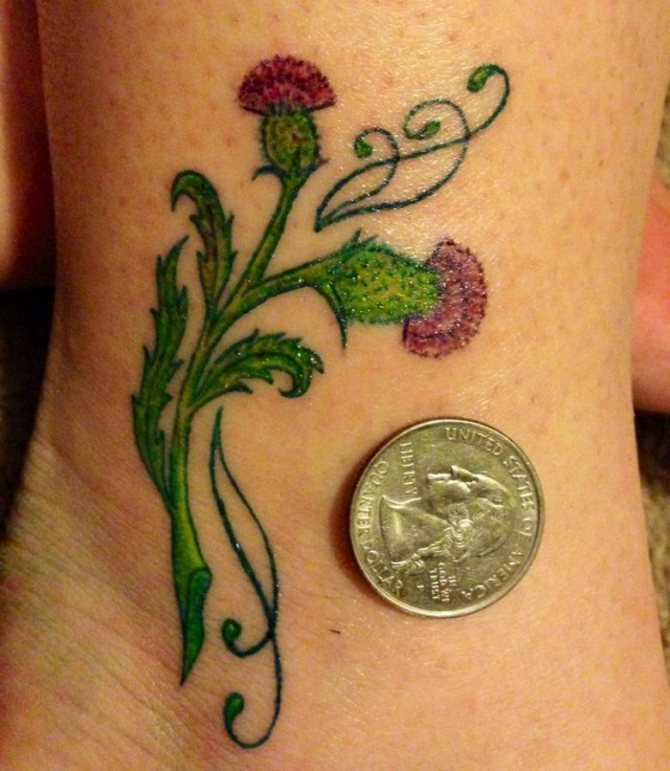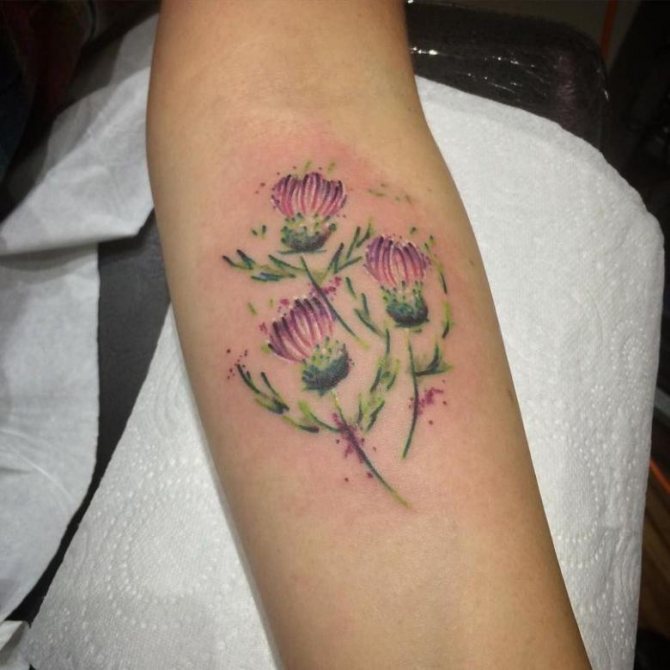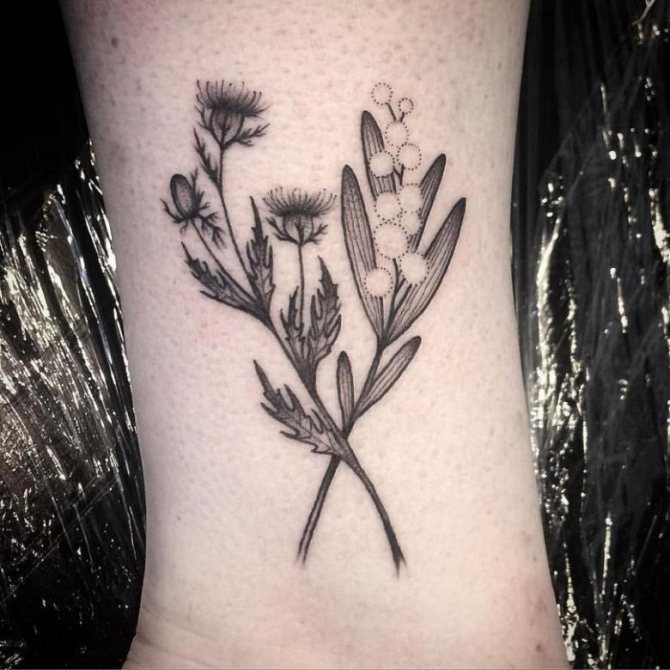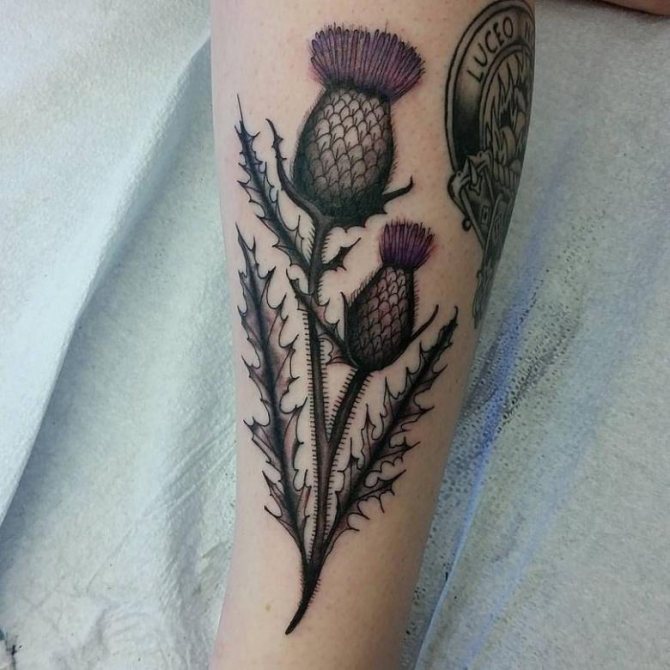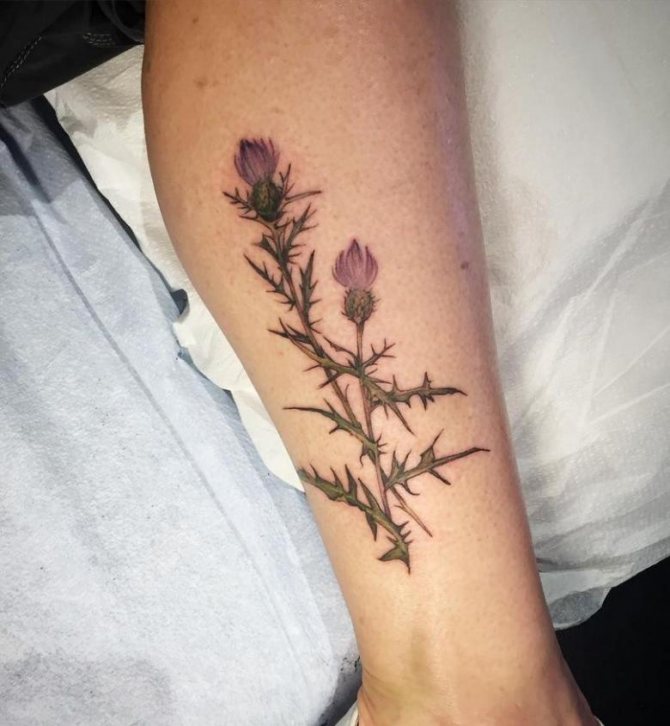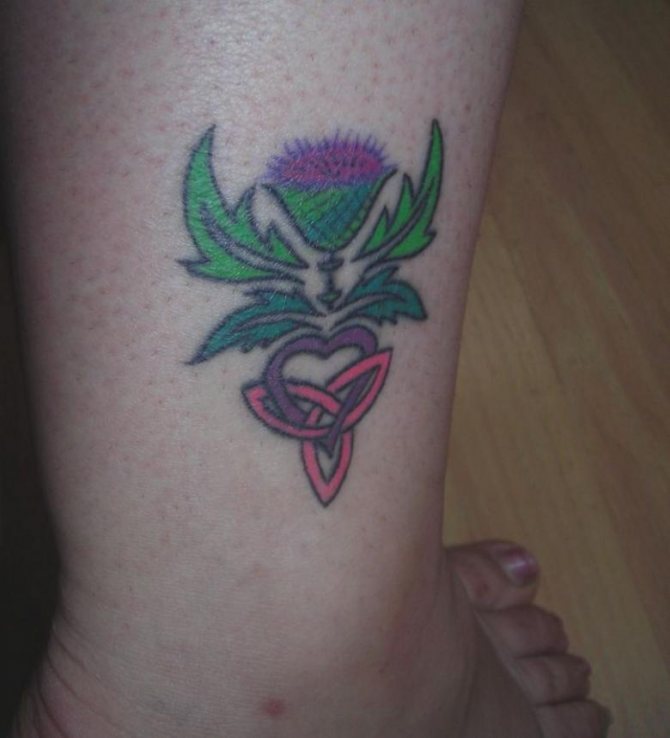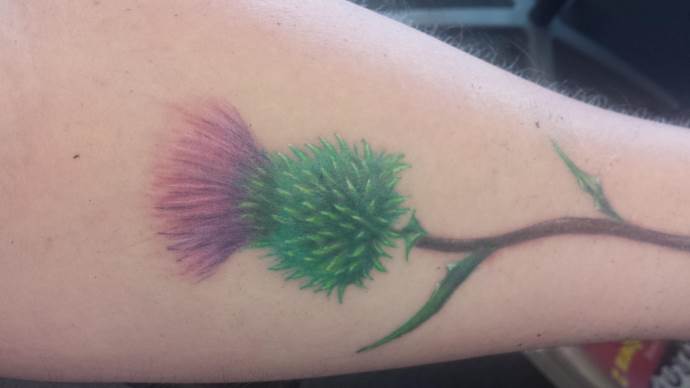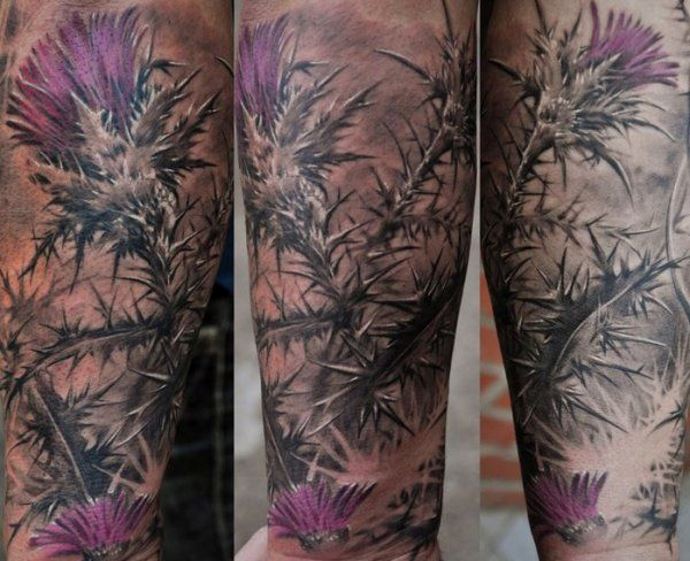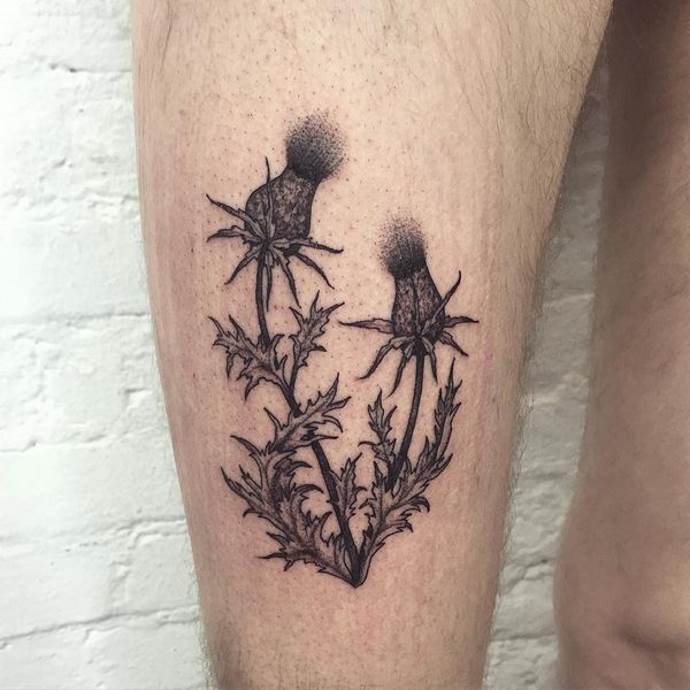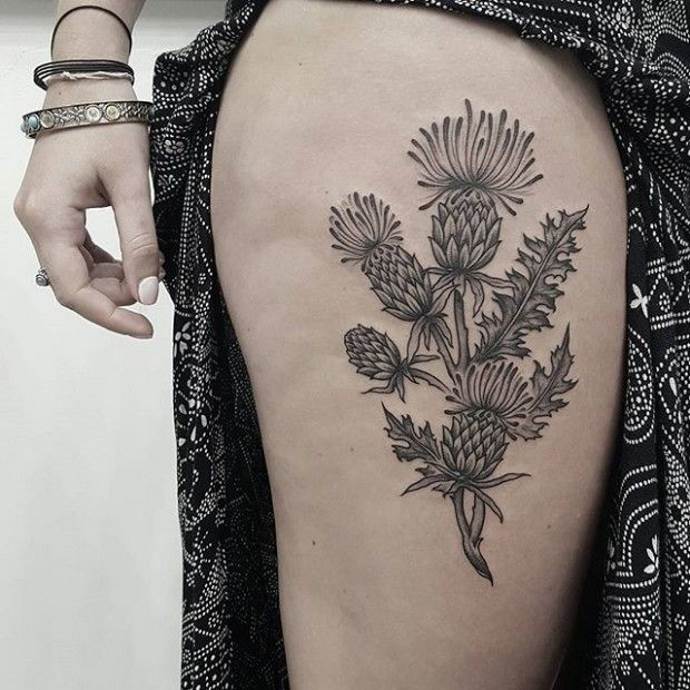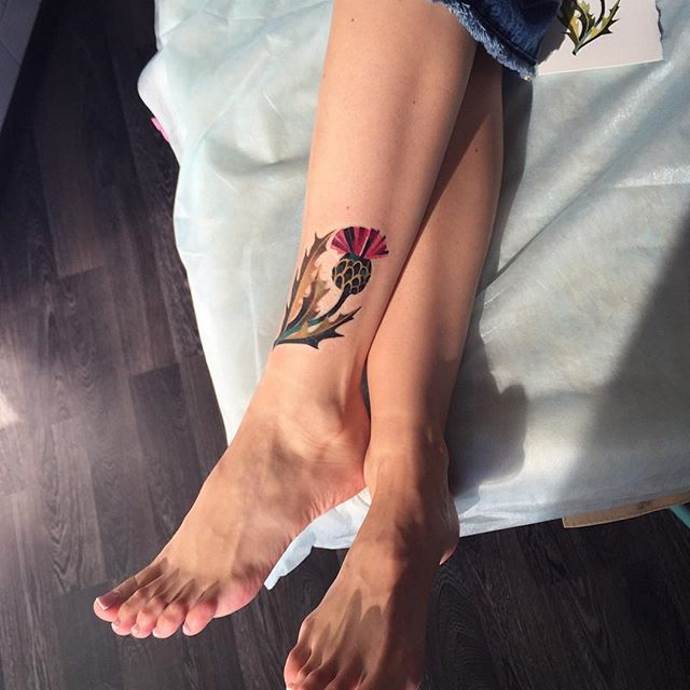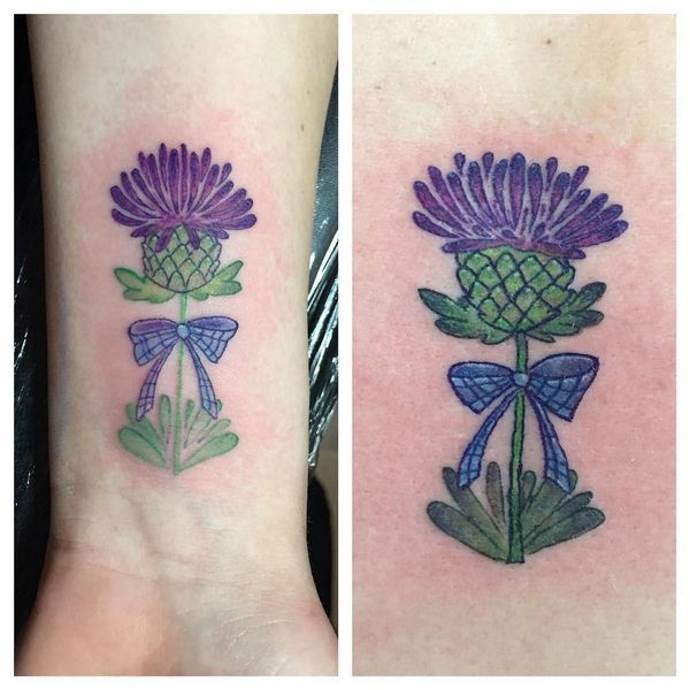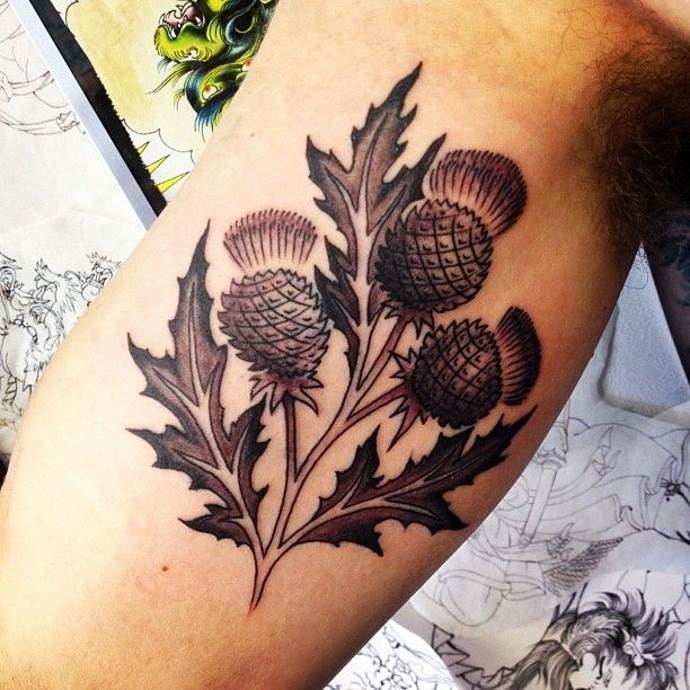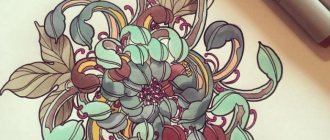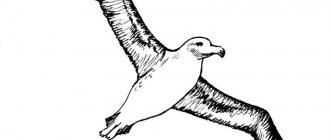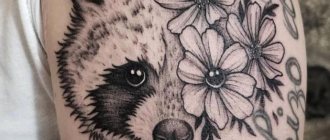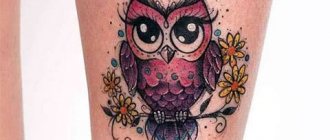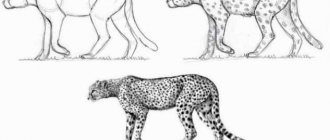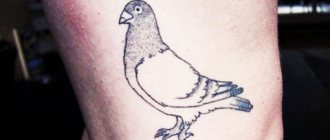Today we propose to find out what the meaning of the tattoo thistle. The word "chertopolokh" from Old Russian is translated as "scaring devils". Interestingly, in the language of flowers, "thistle" means "I am dangerous to deal with".
Since ancient times, the flower was used in various rituals. It is generally believed that the thistle has magical powers and can drive away evil and evil spirits. In addition, it was believed that this plant can protect people from spoilage and the evil eye. If you hang thistles over the doors of the house, it will surely protect against evil spirits.
There are many legends about this plant. One tells the story of how, in the Middle Ages, the fiercest Vikings arrived in Scotland. They were planning an attack and then sneaking out at night for this terrible purpose. However, it turned out that the Vikings got caught in a thicket of thistles. The screaming and cursing caused the warriors to wake up. Thus, the thistle became a real savior for the Scots.
Three hundred years ago the Order of the Thistle arose. It included nobles and knights.
In the Christian religion, the thorns of the plant are associated with the anguish of Jesus Christ, as well as sin and evil.
In iconography, the thistle became an emblem of martyrdom. On the head of Jesus - a crown of thorns, but often many martyrs had wreaths of thistle branches on their heads.
The meaning of the thistle tattoo for women
Sometimes on a woman's body you can see an original drawing in the form of a thistle. It is hardly like a rose or a lily can be called an exquisite decoration. This tattoo is chosen most often not because of its beauty, but because of its special meaning. A thistle body art for a woman will mean:
- faith in God
- desire to achieve success
- Firmness, rigor
- The victory of good over evil.
Wear a drawing in the form of a thistle can choose a believing woman. After all, the plant often represents the agony of Christ.
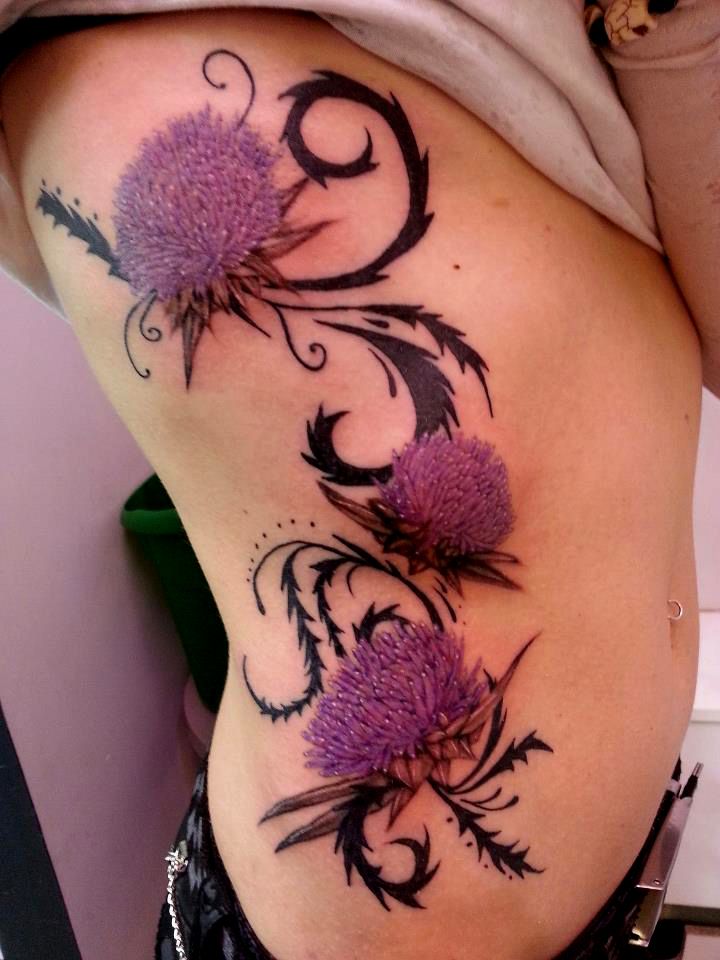
In addition, a tattoo with a thorny plant can mean the desire of the fair sex to achieve success in life. It looks inconspicuous flower has a unique force, and therefore to decorate the body with such a picture can be a woman with a strong, strong-willed character.
It is known that the thistle is able to dispose of the evil. And therefore make a tattoo with such a special flower, a woman can talk about the fact that she always wants to get a victory over evil in all its manifestations.
Coloring and placement
The thistle tattoo looks beautiful and sophisticated in both monochrome and colored versions. The combination of purple petals with greenery, clear lines and a stern silhouette visually looks very good.


Sketch will do masterWho has a lot of experience in applying such drawings. You can do a monochrome version - black is better, so the image remains clear and bright. Stylized flower includes often many shades and elements, performed according to individual request. But the best looks full-color tattoo of a thistle - with rich purple-purple tones, green stem.


Almost any area of the body will be suitable for application. Looks good this straight, elongated flower on the legs and armsAnd on the shoulder and wrist. And if you think of a tattoo in the form of a stem stretched along the spine you will get a very elegant result.
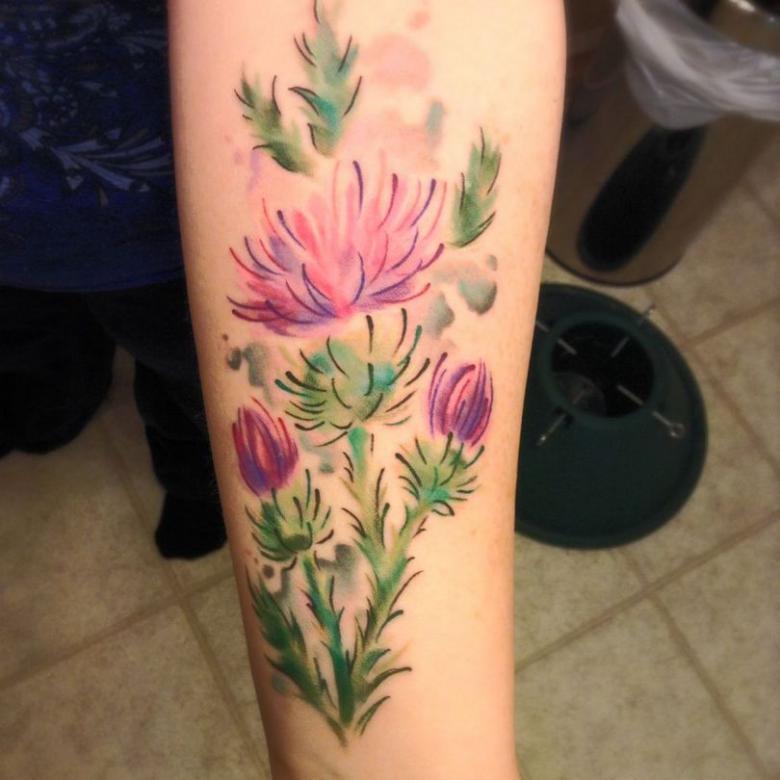

The collection ready Thistle tattoo options, which offered today on the site, will help you choose the best example work.
Today we propose to learn the meaning of the tattoo thistle. The word "thistle" from Old Russian translates as "frightening devils". Interestingly, in the language of flowers, "thistle" means "I am dangerous to deal with".
Since ancient times, the flower was used in various rituals. It is generally believed that the thistle has magical powers and can drive away evil and evil spirits. In addition, it was believed that this plant can protect people from spoilage and the evil eye. If you hang thistles over the doors of the house, it will surely protect against evil spirits.
There are many legends about this plant. One of them tells the story of how, in the Middle Ages, the fiercest Vikings arrived in Scotland. They were planning an attack and then sneaking out at night with this terrible purpose. However, it turned out that the Vikings were caught in a thicket of thistles. The screams and curses caused the warriors to wake up. Thus, the thistle became a real savior for the Scots.
Three hundred years ago the Order of the Thistle arose. It included nobles and knights.
In the Christian religion, thistles are associated with the anguish of Jesus Christ, as well as sin and malice.
In iconography thistle became an emblem of martyrdom. On the head of Jesus - a crown of thorns, but often many martyrs on their heads were wreaths of thistle branches.
The meaning of the thistle tattoo for men
See a tattoo of a thistle can also be seen on the athletic male body. Such a drawing for a representative of the stronger sex will mean:
- determination, willpower
- success
- faith
- depth of soul
Tattoo with a bold thistle is most suitable for men with a strong-willed strong character. Such a drawing will emphasize the priorities for a representative of the stronger sex. So he will tell about the fact that for him is much more important the inner content, rather than the outer shell.
If a man wants to be successful, he also often chooses a body painting with an original flower.
Since the plant symbolizes the anguish of Jesus Christ, then the tattoo with him can do believing people.
Thistle Meaning
Thistle is a prickly weed that is impossible to pick with bare hands. The plant is great to defend itself with its thorns. The Slavs called it so because they believed that the plant repels unclean forces. Thistle smoke was used to smoke the house and cattleshed to protect the home from trouble.
Despite its unsightliness, the weed was honored to be placed on the coats of arms of states and organizations. In the 17th century, the king of Great Britain established the Order of the Thistle. Its purpose was to protect the interests of the monarch against the unruly parliament and the bourgeoisie. The knights wore a star with a thistle placed in the center. The motto of the order stated that any insult would not go unpunished.
The stem with a red corolla decorated the coat of arms of Scotland as a personification of fortitude and courage, a symbol of the country. According to ancient legends, in the 8th century the Danes tried to sneak to the Scots and got ashore from their ships. Under the cover of night the warriors wanted to sneak into the village and exterminate the Scots. To avoid noise, the invaders took their shoes off. They cut their naked feet on thistles and did not hold back their swearing, there was a noise. The Scots woke up, grabbed their swords and crushed the Danes.
In the 15th century, after the heroic defense of the city of Nancy in Lorraine from the troops of the Duke of Burgundy, the thistle appeared on the coat of arms. The motto reads, "He who touches one will be pricked." Indeed, the invader Charles the Bold died in this battle.
Christians associated the flower with the martyrdom of Christ. As a prickly crown was placed on his head. And the higher the weed grows, the more suffering the righteous experience. The plant was a symbol of humility and submission to fate.
In olden times, the weed was used in medicine. It was used to prepare medicines for the stomach. In the Middle Ages, this plant was used to treat plague and melancholy.
In Russia, thistle was considered a talisman against misfortune. When going on a trip, people took a cloth soaked in decoction of thistle. It was believed that this amulet will protect against evil. The weed has the ability to drive away evil forces.
In ancient times, there was a belief that if a pregnant woman ate thistle, she would give birth to a boy.
In China, the flower is associated with longevity and resilience, as it retains its shape even after pruning.
Thistle tattoos are often applied to protect against evil and troubles, against the evil eye and spoilage.
The image of the flower will suit a courageous and austere person who has a combative character and strength. The bearer of the tattoo is prudent and will not interfere in matters of doubtful character. But for myself, he is able to stand up for himself, the offense will not remain unrevenged.
What kind of thistle body art to choose?
Going to the tattoo parlor, it is important to decide in advance on the image. This tattoo is often performed in the style of watercolor. Such a drawing will be effective and bright. Tattoo in this technique is characterized by blurriness. Such an image is very reminiscent of a watercolor drawing.


The work executed in the style of graphics will look original. The shadows in the picture are depicted with the help of various dashes. Here are excluded gray tones.
Also, if desired, you can choose a tattoo in the style of realism. Such a body image will convey even the smallest details of the figure.
It is possible to make a tattoo in the form of a thistle on any part of the body. So it can be shoulder, neck, arm, leg, back and stomach. If you want a voluminous drawing in the form of a bold plant, ask the master to make a tattoo on the back or on the stomach. Before you go to the salon, be sure to look at the photos of the thistle tattoo beforehand and decide on the most suitable sketch.
Ancient amulet
Known since ancient times, the thistle is present on many folk embroideries, used as a heraldic symbol and in magic. Since the plant has thorns in abundance, it was attributed the ability to banish unclean forces and evil. For protection, they made incense from the flowers or smoked thistle smoke in homes and cowsheds.
The thistle is a famous Celtic symbol. A flower with red leaves is present on the coat of arms of Scotland - it symbolizes the resilience of the people. Back in the eighth century, treacherous Danish invaders tried to attack Scottish settlements at night. Undressed to sneak in unnoticed, the invaders stepped on thistles en masse and could not contain their cries. In the end, the Scots were in debt to this humble plantby repulsing the attack.
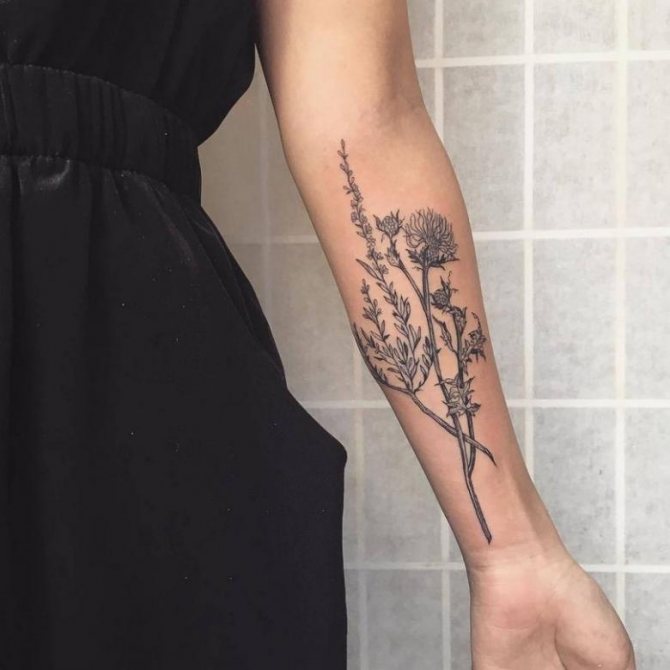

Ancient women believed that eating thistles would help give birth to a boy - it was a clear sign of masculinity.
Medieval knights wore the flower in conjunction with a star on their flag or coat of arms - it was a sign that insults were not forgiven, honor was protected. The thistle played a role in the battle of Nancy in Lorraine - it was worn on his coat of arms by the Duke of Burgundy. His surname's motto read: "He who touches it will be pricked." Charles the Bold, who attacked Lorraine, died in this battle.


In the seventeenth century, the Order of the Thistle was founded in Britain. The organization was engaged in supporting the monarchy in times of turmoil - parliament and the bourgeoisie were out of control.
For Christians it is a true attribute of Christ and his torment, to whom a crown of thorns was placed on his head. It was a sign of resignation and humility before adversity.


Thistle was often used in medicine, especially for the stomach, but also for plague and melancholy. It is a symbol of The most secretive and somber sign of the zodiac - Capricorn, which knows how to overcome any difficulties.


The Slavs had a thistle tattoo or flower itself were amulets against the evil eye. Travelers took a cloth soaked in decoction of thorns - it was a powerful amulet. In China, the flower was also considered an image of fortitude and longevity, because the weed kept its shape for a long time after it was cut.
